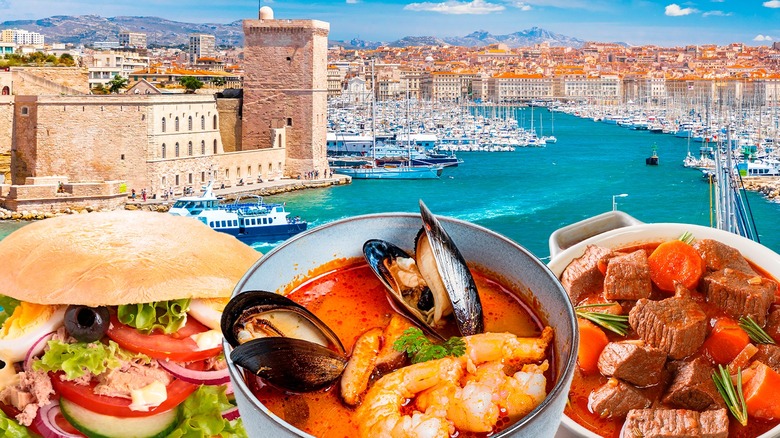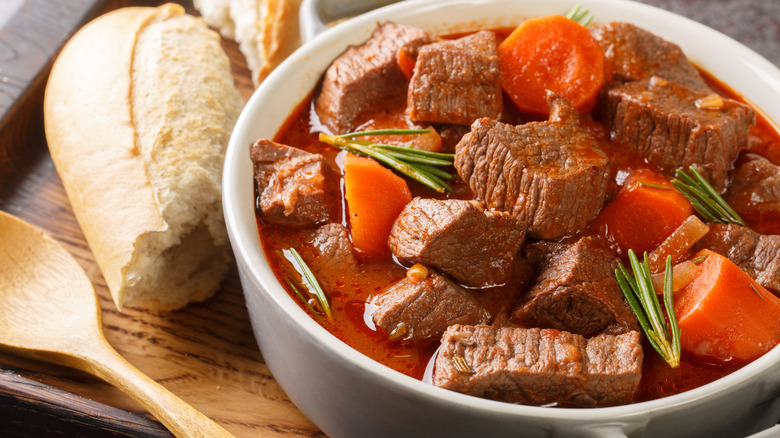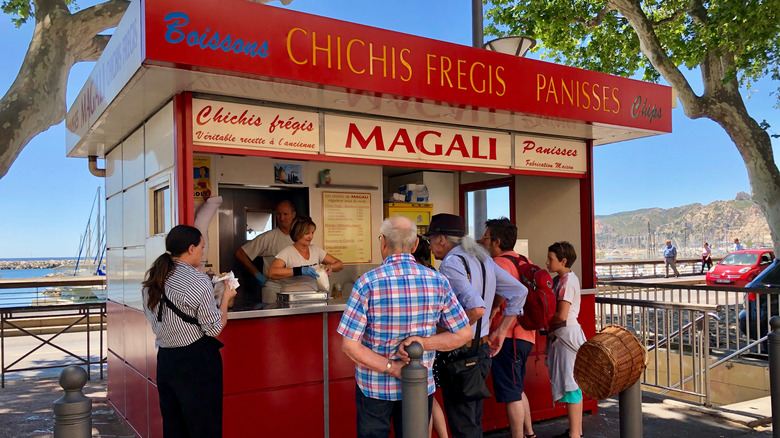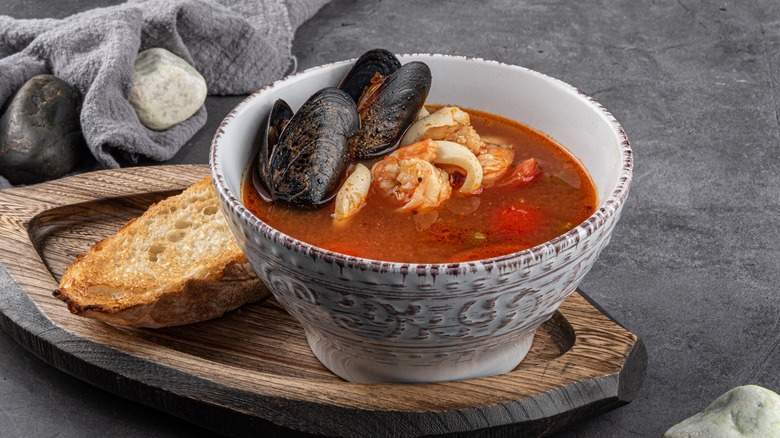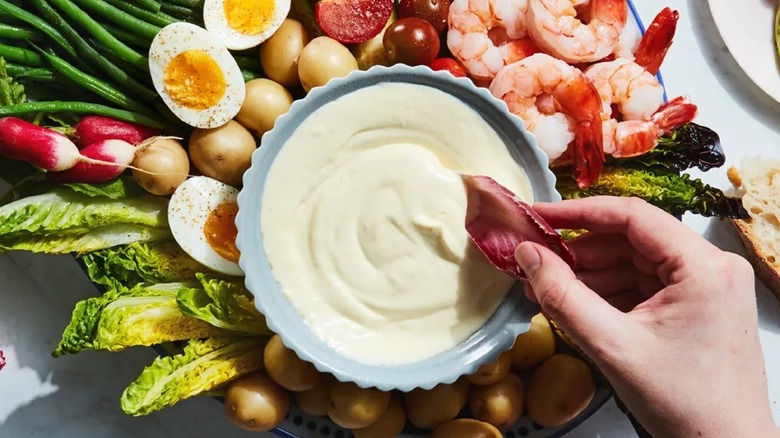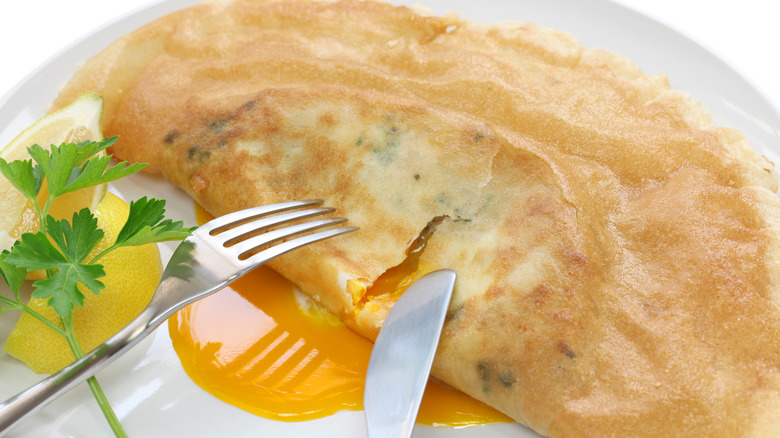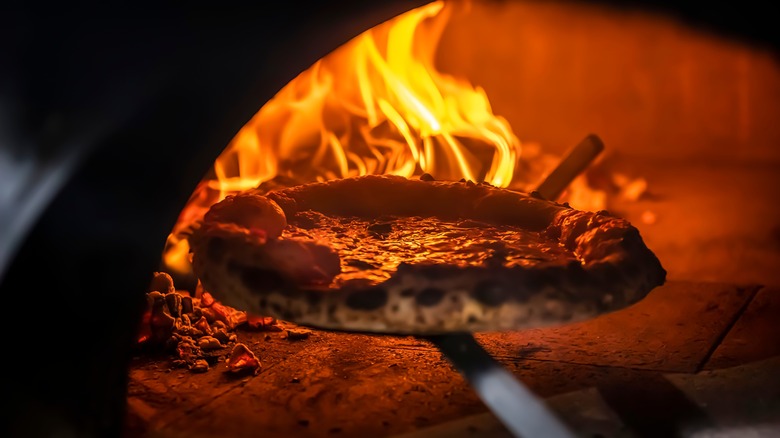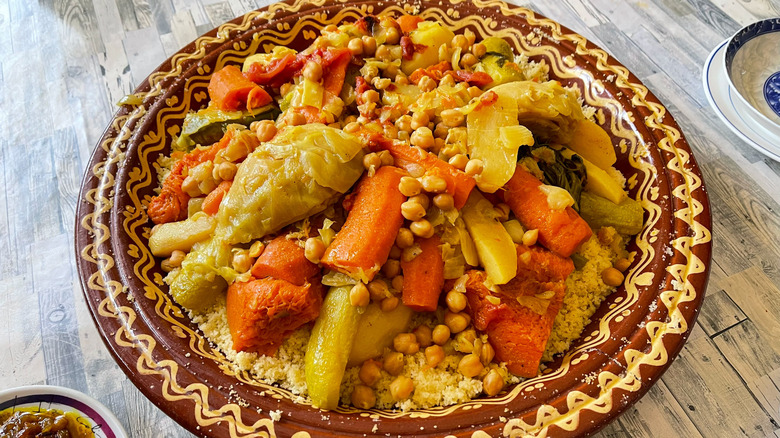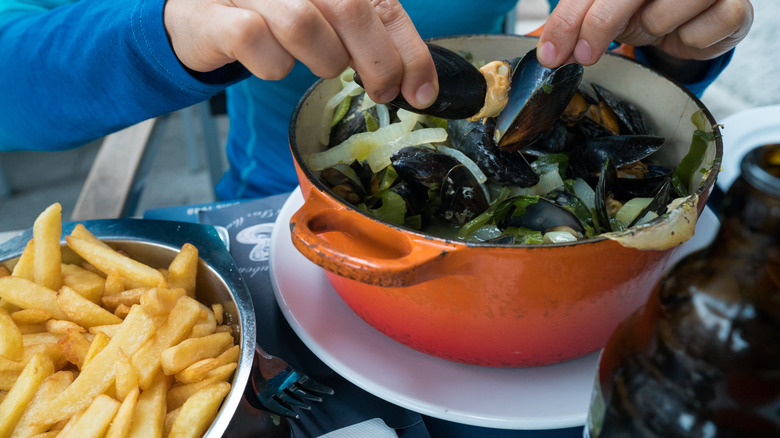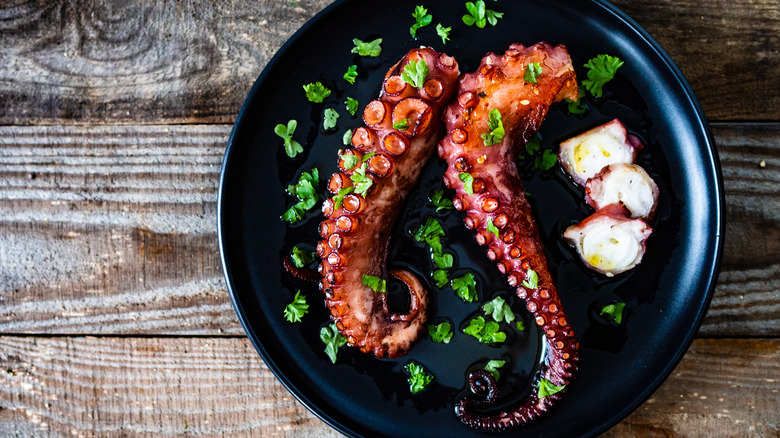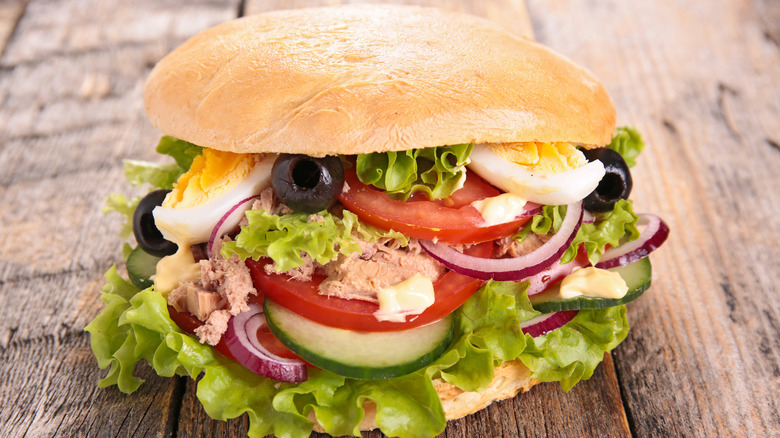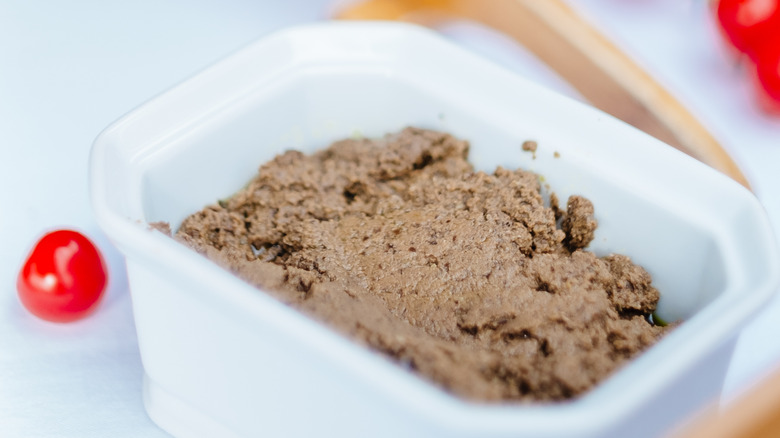The 12 Best Classic Dishes To Try In Marseille, France
If you've been to Marseille, you know just how proud the locals are of their city. Conversations become especially animated when they turn to all things edible. The city has much to offer in terms of cuisine. Being the second largest city in France, Marseille is a focal point for the culture of Provence and the south of France as a whole. It also offers lots of fresh seafood dishes, due to its port-side location. Furthermore, Marseille is one of the most diverse cities in France. That means that many foods from North Africa, West Africa, Italy, and Vietnam, among other places, have come to shape the city's cuisine.
This convergence of ingredients and cultures make the city's cuisine dynamic and complex. As an expat and food writer, I spent years exploring this scene, from traditional choices to out-of-the-box options. Where's a new diner supposed to start? I have the answers. These are 12 of the best classic dishes to try in Marseille.
Daube provençale
When it comes to French beef stews, most visitors have only heard of boeuf bourguignon. In the south of France, however, you're more likely to find its cousin, daube provençale. Daube is a beef based stew, but sometimes other ingredients like lamb are used. The difference between daube and boeuf bourguignon is that boeuf bourguignon is cooked with red wine from the Burgundy region and vegetables like mushrooms and baby onions. With daube, meat is braised in red or white wine and cooked with foods more common to the Mediterranean, like tomatoes, garlic, large onions, herbes de Provence, and sometimes olives.
Daube is also cooked in a special pot, called a daubière. This old-school pot, often made from clay or copper, was created to be used over coals, as was common in the 19th century. Its unique design encourages a flow of steam and condensation, which allows the daube to be cooked long and slow. This is essential, as the cuts of meat used in this dish tend to be tougher, full of tendons and collagen-filled bone marrow. Today, though, most people use a modern pot and cook daube in either the oven or on the stovetop . However it's cooked, it's a tender, flavor-packed dish that's as comforting as it is delicious.
Panisse
Panisse are one of Marseille's most popular snacks. Made from chickpea flour and olive oil, these little fries are cut into rounds or batons, then deep fried. They're golden brown and crispy on the outside, while remaining soft and fluffy on the inside — kind of like polenta fries, but smoother and lighter.
Panisse are often served plain with salt and pepper, a light yogurt dip, or some simple ketchup. You can find them in little snack shacks on the seaside, often served alongside chichis fregis, a sweet fried chickpea snack. Typically, you'll get them in a paper cone, straight out the fryer. You can also snag them at most traditional restaurants, brasseries, and cafes. They're frequently served as a starter, or as a side to your main meal. Some sandwich shops even have them as a side option. As panisse are really light and very moreish, you're sure to eat them more than once during a single trip.
Panisse has Italian origins in a similar food called fainâ. The recipe was brought with Italian factory workers who came to the south of France from places like Piedmont and Liguria. A similar chickpea snack can be found all over the Mediterranean — socca in Nice and calentica in Algeria are comparable edibles.
Bouillabaisse
Bouillabaisse is Marseille's most iconic dish. This hearty soup, full of the flavors of the sea, is essentially a must-try for all tourists. Like many beloved traditional dishes, bouillabaisse comes from humble origins. Left with the scraps of fish they hadn't sold from their day's catch, fisherman simmered them all together, creating a tasty, satisfying soup.
But while it may have originated as a cheap meal, it's now one of the most expensive dishes in Marseille. Modern bouillabaisse is a deeply complex dish, with numerous steps, techniques and a long ingredient list. Recipes and ingredients change from cook to cook, engendering many debates about what makes a truly authentic bouillabaisse. Some standby ingredients include clams, lobster, saffron, fennel, and garlic, creating an umami-rich soup. Although it's a little hard on the pocket, you should give it a try at least once to get the authentic experience. Then, you can make classic French bouillabaisse at home with much cheaper ingredients and less fuss.
Aïoli
Many people think of aioli as a mayonnaise-esque sauce, but in France, aïoli is a little bit different. Marseille aïoli is built on a base of emulsified olive oil and garlic. It also usually includes egg yolk, and sometimes lemon juice and herbs. So far, so good. However, when you're browsing the restaurant menus of Marseille, you may be confused to see it offered as a dish unto itself, with a much higher price than you'd expect for a dip.
In this case, aïoli is a full meal. The sauce typically comes with a large plate of cod, vegetables, and hard boiled eggs. These simple ingredients are dipped into the sauce so that diners can really savor it. In some restaurants, seafood like prawns, sea snails, and mussels are also on offer. This dish sometimes goes by "aïoli garni" or "grand aïoli," but if you say aïoli, people will know you're referring to this well-stocked plate.
Brik
Brik (pronounced "breek") is one of Marseille's most delicious snacks. It's a Tunisian deep-fried egg pastry that you can find at numerous North African restaurants and food vendors. The Noailles neighborhood near the city center is your best bet: Noailles is a historically North African neighborhood, and thus a hub for all sorts of delicious treats from Morocco, Egypt, Tunisia, and Algeria. Brik is usually filled with a variation of onions, garlic, tuna, potatoes, herbs, spices, and, of course, egg. When you cut through a well-made brik's center, the still-liquid yolk oozes out in delicious profusion. If that puts you off, though, you can always order one well cooked.
Brik is further distinguished by its delicate pastry. It's something of a combination between an extra thin crepe and a spring roll. When fried, this shell becomes pleasantly crisp and feather-light. Notably, you can sometimes find this dish under a different name: bourek. This is what it's called in Algeria. It's usually eaten for breakfast, but you can also find it as a starter in many North African restaurants.
Pizza
There's great pizza on every corner in Marseille. That might seem strange, but in fact, many Marseillaise believe that wood-fired pizza was actually invented in Marseille before it came about in Italy. Others claim its popularity has to do with the fact that many Italians and Corsicans came to live in Marseille throughout history. Whatever the history, pizza is solidly considered a typical Marseille food, and one you should definitely enjoy when visiting.
You'll find pizza trucks all over the city selling a slice for under 2 euros. Indeed, many locals depend on these slices for their lunch, or as an after work snack. There are also plenty of French restaurants that serve pizza, and of course dozens of Italian restaurants that do the same. To find particularly good wood-fired pizza, look for signs that say "au feu de bois."
Couscous
It would be a shame to visit Marseille (or France in general) and not take advantage of its many great North African restaurants. One of their most popular dishes is couscous. It's become part of the fabric of French cuisine, to the point that it's rare to find a French restaurant that doesn't serve it, at least as a side.
In many North African cultures, couscous is a centerpiece dish, often eaten during big celebrations, like weddings. In Marseille, its popularity has made it a more everyday creation — you can see signs for it everywhere. Though it's easy to mistake for a grain, given the fact that it's made up of tiny spheres of starchy goodness, it's actually a type of pasta. Typically, couscous is steamed until soft and tender, then topped with vegetables, meat, and sometimes nuts and dried fruits. Often, it's also served with a flavorful tomato based broth, which you can pour over the golden mound to your heart's content. Whether cooked with carrots, chicken, lamb, zucchini, or merguez sausage, it's always delicious.
Navettes
Navettes are the only sweet food that appears on this list, and that's because they're an incredibly important comestible for the people of Marseille. Plus, they're not very sweet. But though these boat-shaped biscuits might seem simple on your first try, the more you eat, the more you'll grow to appreciate them. A tour guide once told me that they were created as a long-lasting food that fishermen could take with them at sea. That makes sense, as these biscuits aren't as richly buttery as other standbys of French confectionery. They're actually quite hardy, in fact. But navettes are also pleasantly tender, and traditionally perfumed with orange blossom water, giving them a unique taste. Nowadays you can also find lemon, almond, or differently flavored navettes, but the orange blossom ones offer the most authentic experience.
To try some of the best navettes in the city, visit Marseille institution Les Navettes des Accoules. This family-run bakery has been around since the '80s, and specializes in baking the traditional biscuits of Marseille, Corsica, and Provence in general. You might have to stand in a long queue of both locals and tourists, but it's worth the wait.
Moules frites
Moules, which means mussels in French, are one of the best seafood dishes to indulge in while in Marseille. Mussels are plentiful all over the city, and are subject to various cooking styles. But no matter what, they're always served with a side of frites, aka fries. If you're at the port — the main tourist area — you'll find plenty of restaurants serving moules, mostly in steaming pots that are enough to share between two or more people. They're typically fresh and well prepared in this area, but it's always good to check some reviews so as not to get caught in a lackluster tourist trap.
You won't find a lot of creamy mussels around. The south of France prefers white wine steamed mussels with shallots, garlic, butter, and parsley — the perfect sauce for dipping your fries into. This style is called moules marinière. While not historically a traditional Marseille dish, moules marinière has made its way from the north of France and become a Marseille favorite. You can also find breaded mussels, which are served open shelled with buttery breadcrumbs.
Poulpe
Another type of seafood that you'll find in abundance in Marseille is octopus. In French, octopus is called poulpe, and although it's not necessarily a traditional Marseille dish, it's hard to find a brasserie in the city that doesn't have a poulpe dish on its menu. It's usually fresh and prepared quite simply, so you can savor the pure taste of fresh octopus. Grilling until tender is a popular technique, so you won't have any trouble with chewy or tough octopus. The Marseillaise know what they're doing.
If you've never tried octopus before and are a little intimidated by the suckers on the tentacles, don't worry. They don't feel weird or behave like suction cups at all. The texture is similar to grilled squid, just with a larger mass. Squeeze some lemon juice on it, slice a piece off with your knife, and take a bite. You'll never look back.
Pan bagnat
If you're looking for something to eat on the go or at a picnic on the beach, then pan bagnat is the perfect food. Pan bagnat is a French tuna sandwich you absolutely need to try. Meaning, "bathed bread," this sandwich is characteristically soggy, but in the best way. Made with tuna, egg, salad, olives and capers, it's full of flavor in every bite. Basically, it's a Niçoise salad in a bun.
The local theory is that it gets tastier the longer it sits, so people often make it ahead of time for their outdoor excursions to the park or beach. Hence, the sogginess. However, the bread is sturdy and usually a crusty variety, which allows for sogginess without falling apart. When well made, pan bagnat is soft on the inside, yet still chewy and crisp on the outside.
Anchoïade
Anchoïade is all about anchovies, so if you're not a fan of this polarizing ingredient, this dip isn't for you. However, if you love the robust umami of this little fish then this distinctive French anchovy dip is heaven in your mouth. Like tapenade, anchoïade is a traditional appetizer from this region of France. While slightly old school, you can still find this tasty mixture being served for apero (the French version of an aperitif, or snacks and drinks before dinner) in people's homes and seaside restaurants.
This tasty treat is made with just four ingredients: anchovies, red wine vinegar, garlic, and olive oil. Traditionally, these are mashed together with a mortar and pestle or by hand with a fork, but chefs can easily pulse them in a food processor to get the same result. It's dark, salty, fishy, and goes great on a cracker or a piece of fresh baguette, especially with a glass of white wine or champagne on a warm summer evening. It will also certainly awaken your appetite for your main meal, just as it's meant to do.
